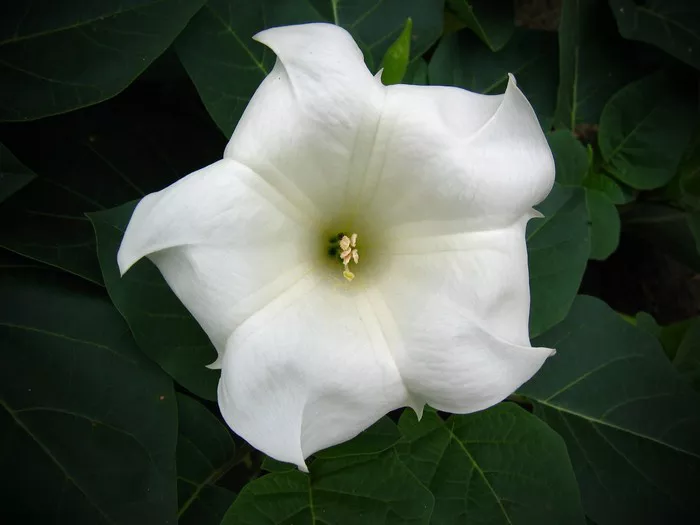Moon flowers, with their ethereal allure and captivating beauty, have long enchanted botanists, poets, and garden enthusiasts alike. These nocturnal blossoms possess a mystical quality, blooming only under the silvery light of the moon, evoking a sense of wonder and fascination. In this comprehensive guide, we delve into the mesmerizing world of moon flowers, uncovering their unique characteristics, cultural significance, and cultivation techniques.
The Enigmatic Appearance of Moon Flowers
At first glance, moon flowers appear as delicate, white blooms, reminiscent of their celestial namesake. However, their allure lies not only in their color but also in their exquisite structure and nocturnal blooming behavior.
Moon flowers belong to the genus Ipomoea, encompassing over 500 species of flowering plants, including the well-known Ipomoea alba, or moonflower vine. These plants typically feature large, trumpet-shaped flowers with a diameter of up to six inches (15 centimeters). The petals of the moon flower unfurl in the evening, releasing a sweet, intoxicating fragrance that permeates the night air.
One of the most distinctive features of moon flowers is their ephemeral nature. Unlike many other flowers that bloom during the day, moon flowers open their petals exclusively at nightfall, attracting nocturnal pollinators such as moths, beetles, and bats. This adaptation to the nighttime environment adds to their enigmatic allure and makes them a captivating addition to moonlit gardens.
Cultural Significance and Symbolism
Throughout history, moon flowers have held symbolic significance in various cultures around the world. In many traditions, these nocturnal blooms are associated with mystery, magic, and the divine feminine.
In Hindu mythology, moon flowers are revered as sacred symbols of the goddess Saraswati, the embodiment of knowledge, music, and art. According to legend, Saraswati is often depicted adorned with moon flowers, symbolizing her divine presence and creative power.
Similarly, in ancient Greek mythology, moon flowers are linked to the lunar goddess Selene, who is said to ride across the night sky in her silver chariot, scattering moon flowers in her wake. These blossoms are believed to represent the moon’s radiant beauty and the cyclical nature of life and death.
In contemporary culture, moon flowers continue to inspire awe and fascination, appearing in literature, art, and folklore as symbols of love, transformation, and the mysteries of the night. Their delicate petals and intoxicating fragrance evoke a sense of romance and enchantment, making them popular choices for moonlit gardens and moon-themed events.
Cultivation and Care
While moon flowers possess an aura of mystique, they are surprisingly easy to cultivate, making them an excellent choice for both novice and experienced gardeners. Here are some essential tips for successfully growing and caring for these captivating blooms:
1. Selecting the Right Location: Moon flowers thrive in full sun or partial shade, so choose a location in your garden that receives at least six hours of sunlight per day. Additionally, ensure that the soil is well-drained and rich in organic matter to promote healthy growth.
2. Planting Seeds or Seedlings: Moon flowers can be grown from seeds or seedlings, depending on your preference. If starting from seeds, soak them in warm water overnight to soften the seed coat and aid germination. Plant the seeds or seedlings in the spring after the last frost date, spacing them 6-12 inches apart.
3. Providing Support: Moon flowers are vigorous climbers and require support to reach their full potential. Install trellises, arbors, or fences for the vines to climb, ensuring that they have ample room to spread and flourish.
4. Watering and Fertilizing: Keep the soil evenly moist but not waterlogged, especially during hot, dry periods. Water the plants at the base to prevent fungal diseases and avoid wetting the foliage. Apply a balanced fertilizer every 4-6 weeks during the growing season to promote healthy growth and abundant blooms.
5. Pruning and Deadheading: Regular pruning and deadheading help maintain the shape and appearance of moon flower vines while encouraging continuous blooming. Remove spent flowers and trim back any overgrown or tangled stems to encourage new growth and flowering.
6. Protecting from Pests and Diseases: Moon flowers are relatively resistant to pests and diseases, but occasional problems may arise, such as aphids, spider mites, or powdery mildew. Monitor the plants regularly for signs of infestation or disease and take appropriate measures, such as handpicking pests or applying organic insecticides or fungicides as needed.
7. Harvesting Seeds: To save seeds for future planting, allow some of the moon flowers to mature and develop seed pods. Harvest the pods when they turn brown and dry, then remove the seeds and store them in a cool, dry place until ready for sowing.
By following these simple guidelines, you can cultivate a stunning display of moon flowers in your garden, transforming your outdoor space into a magical oasis of nocturnal beauty and enchantment.
Conclusion
Moon flowers, with their luminous blooms and nocturnal allure, continue to captivate and inspire gardeners, artists, and dreamers around the world. From their enigmatic appearance to their rich cultural symbolism, these ethereal blossoms embody the magic and mystery of the night, inviting us to pause, reflect, and marvel at the wonders of the natural world.
Whether adorning moonlit gardens, inspiring works of art, or symbolizing timeless themes of love and transformation, moon flowers hold a special place in the hearts and imaginations of all who encounter them. As we cultivate and care for these celestial blooms, we honor their beauty and celebrate the enduring connection between humanity and the natural world.


